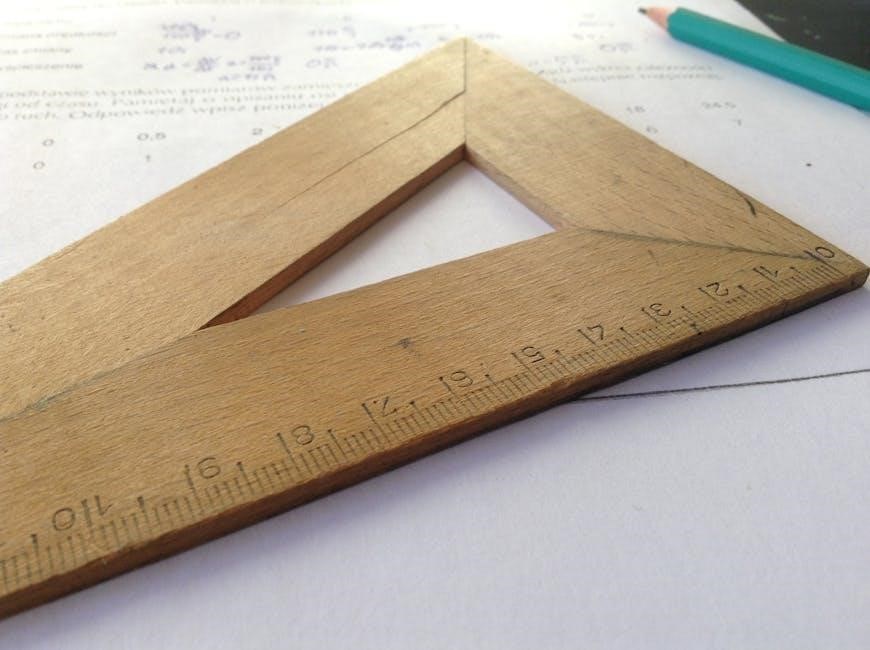Middle school math placement tests are designed to assess a student’s mathematical understanding and readiness for specific courses. These tests evaluate fluency in various math concepts, helping educators determine appropriate placements. They are essential tools for ensuring students are challenged appropriately and supported in their learning journey.

Understanding the Purpose and Structure of the Test
The middle school math placement test is designed to evaluate students’ mathematical skills and determine their readiness for specific courses. Its primary purpose is to assess understanding of key concepts, ensuring appropriate placement in math classes. The test is structured to gradually increase in difficulty, covering topics such as arithmetic, algebra, geometry, and problem-solving.
Students typically have up to one hour to complete the test, which includes multiple-choice questions and open-response items. The format allows teachers to identify strengths and areas needing improvement. The test is not foolproof but serves as a valuable tool for guiding placement decisions.
It aligns with curricula like Saxon Math, covering content from programs such as Math 5/4, Math 6/5, and Algebra 1. Results help teachers recommend courses like Math 54, Math 65, or Math 76, ensuring students are challenged but not overwhelmed. The test is not meant to cause anxiety; it is simply one of many tools used to support student success.
Key Topics Covered in the Middle School Math Placement Test
The middle school math placement test covers a variety of essential math topics to assess a student’s readiness for higher-level courses. Key areas include arithmetic operations, such as decimals and fractions, and algebraic concepts like solving for variables and understanding order of operations. Geometry topics, such as calculating perimeters and areas of various shapes, are also included.
The test evaluates problem-solving skills through word problems and practical applications. Additionally, it assesses understanding of prime factorization and percentage conversions. These topics are crucial for building a strong foundation in mathematics, ensuring students are prepared for advanced courses like Algebra 1. The test is structured to gradually increase in difficulty, allowing for a comprehensive evaluation of each student’s mathematical fluency. By focusing on these key areas, the placement test helps educators determine the most suitable math course for each student, supporting their academic growth and success.

How to Prepare for the Middle School Math Placement Test
Preparation for the middle school math placement test involves a combination of review, practice, and strategic planning. Start by familiarizing yourself with the test format, which often includes multiple-choice questions and problem-solving scenarios. Focus on reviewing key math concepts such as arithmetic operations, algebra, and geometry. Practice with sample questions to build confidence and improve problem-solving speed.
Use online resources or study guides to target areas where you need improvement. Time management is crucial, so practice skimming questions and prioritizing those you can answer quickly. Avoid guessing randomly; instead, eliminate incorrect options and make educated guesses. Additionally, ensure you are well-rested and maintain a positive mindset before the test.
Lastly, consider seeking guidance from teachers or tutors to address specific weaknesses. By combining consistent practice with a thorough understanding of the test structure, you can approach the placement test with confidence and readiness. Regular review and focused preparation will help you achieve your best performance;

Sample Questions and Answer Types
The middle school math placement test includes a variety of question types to assess different skills. Multiple-choice questions are common, requiring students to select the correct answer from a set of options. For example, a question might ask:
“What is the value of x in the equation 2x + 5 = 11?”
with options like A) 2, B) 3, C) 4, D) 5.
Short-answer questions may also be included, where students provide numerical or algebraic responses. For instance:
“Simplify the expression: 3(2x — 1) + 4”.
Word problems are another key component, testing a student’s ability to apply math to real-world scenarios. An example might be:
“A book costs $15. If tax is 8%, how much will you pay in total?”
Some tests feature open-response questions, allowing students to demonstrate their problem-solving processes. These may include geometry problems or multi-step algebraic solutions. Additionally, questions often increase in difficulty as the test progresses, ensuring a comprehensive assessment of mathematical fluency. Familiarizing yourself with these question types will help you navigate the test confidently.

Interpreting Test Results and Placement Recommendations
The results of a middle school math placement test provide valuable insights into a student’s mathematical proficiency and readiness for specific courses. Typically, the test yields a raw score, which is then compared to benchmarks to determine the appropriate math level for the student. For instance, a high score might indicate readiness for advanced courses like Algebra 1, while a lower score may suggest the need for foundational math classes.
Teachers and administrators use these results to recommend course placements, ensuring students are challenged appropriately without being overwhelmed. The test is not infallible, so schools often consider additional factors, such as a student’s prior academic performance and teacher evaluations, when making placement decisions. Parents and students are usually provided with a detailed breakdown of the results, highlighting strengths and areas for improvement.
It’s important to note that placement recommendations are not set in stone. Students who feel misplaced can often request reassessment or consult with teachers to adjust their placement. Accurate interpretation of test results is crucial to ensure students are well-positioned for success in their math education.
The Role of Teachers in Using Placement Test Results
Teachers play a pivotal role in interpreting and utilizing middle school math placement test results to guide students’ academic journeys. They analyze the scores to identify individual strengths and areas where additional support may be needed. This analysis helps teachers make informed decisions about course placements, ensuring students are appropriately challenged and supported.
Beyond placement, teachers use test results to tailor their instruction, addressing specific gaps in knowledge and skill. For example, if a test reveals that a student struggles with prime factorization, the teacher can incorporate targeted exercises into their lessons. Additionally, teachers often share test insights with parents and students, providing a clear understanding of progress and areas for improvement.
Teachers also use placement test data to recommend resources for further practice and review. They may suggest specific textbooks, online tools, or summer programs to help students bridge gaps or accelerate their learning. By leveraging test results effectively, teachers ensure that every student has the opportunity to succeed in their math education.

Common Mistakes to Avoid During the Test
During a middle school math placement test, students often make avoidable mistakes that can impact their results. One of the most common errors is rushing through questions without reading them carefully. This can lead to misinterpreting the problem or missing key details. Another mistake is failing to manage time effectively, resulting in unanswered questions or incomplete work.
Some students also make the mistake of guessing randomly without eliminating incorrect options first. This strategy can lower their chances of selecting the right answer. Additionally, many students neglect to use scrap paper for calculations, which can increase the likelihood of mental math errors.
It’s also important to avoid panicking or losing confidence during the test. Stress can cloud thinking and lead to careless mistakes. Students should take deep breaths and approach each question methodically. Finally, neglecting to review answers when time permits is a common oversight. Reviewing ensures that errors can be corrected and improves overall performance. By being mindful of these pitfalls, students can maximize their potential and achieve more accurate placement results.

Strategies for Time Management During the Test
Effective time management is crucial for performing well on a middle school math placement test. Start by skimming through the entire test to gauge the difficulty and number of questions. This helps in allocating time wisely. Allocate a specific amount of time to each question based on its complexity, ensuring you leave some buffer for review.
Prioritize questions you feel confident about first to secure early points. For questions that seem challenging, skip them initially and return later. This prevents wasting time on a single problem and allows you to attempt more questions overall. Use scrap paper for calculations to avoid mental math errors and keep track of your progress.
Another strategy is to manage your pacing by dividing the test into sections. For example, spend 10-15 minutes on easier questions and allocate more time to complex problems. Avoid spending too long on a single question, as this can lead to running out of time for others.
Finally, stay calm and focused. Taking deep breaths can help maintain concentration and reduce anxiety. By adhering to these time management strategies, students can efficiently complete the test and demonstrate their true mathematical abilities. Proper planning ensures that no question is left unanswered and that there is time to review answers before submission.

Resources for Practicing and Reviewing Math Concepts
To excel in a middle school math placement test, it’s essential to utilize available resources for practice and review. Online platforms like Khan Academy and CK-12 offer free, interactive math exercises and video tutorials tailored for middle school students. Additionally, many schools provide practice tests or study guides specific to their placement exams, which can help familiarize students with the format and content.
Printable worksheets from educational websites such as Math-Drills or K5 Learning can reinforce concepts like prime factorization, decimals, and algebraic expressions. Flashcards are another effective tool for quick revision of math facts and formulas. Textbooks like Saxon Math 65, Math 76, and Math 87 are recommended for in-depth review of topics covered in the placement test.
Timed practice tests are crucial for improving time management skills. Students can find sample tests online or use resources provided by their schools to simulate exam conditions. Consistent practice ensures a strong foundation in math concepts, boosting confidence and readiness for the placement test. By leveraging these resources, students can achieve their best possible performance. Regular review and practice are key to success.
Understanding the Importance of Accurate Placement
Accurate placement in middle school math is crucial for a student’s academic success. It ensures that learners are neither overwhelmed by advanced content nor bored by material they’ve already mastered. Placement tests help identify the appropriate level of challenge, fostering engagement and growth.
When students are placed correctly, they are more likely to build confidence and develop a positive attitude toward math. Misplacement can lead to frustration or disengagement, potentially affecting long-term academic performance. Additionally, accurate placement ensures that students are well-prepared for high school math courses and future STEM opportunities.
Teachers also benefit from accurate placement, as it allows them to tailor instruction to meet the specific needs of their students. This personalized approach enhances the effectiveness of lessons and supports the overall learning environment. Thus, accurate placement is not just about test results—it’s about setting students up for long-term success and fostering a love for learning math. By ensuring each student is in the right course, schools create a foundation for achievement that extends beyond middle school.

Final Tips for Success on the Placement Test
To excel on the middle school math placement test, students should adopt a strategic and calm approach. Begin by familiarizing yourself with the test format and content to reduce anxiety. Practice regularly using sample questions and review resources to strengthen weak areas.
Time management is critical; allocate your time wisely to avoid rushing through questions. Read each problem carefully, and eliminate incorrect answers to increase your chances of selecting the right one; Maintain a positive mindset—confidence can significantly impact performance.
Lastly, ensure you are well-rested and prepared on test day. A clear mind and focused attitude will help you demonstrate your true mathematical abilities. By following these tips, students can approach the placement test with confidence and achieve their best possible results.
